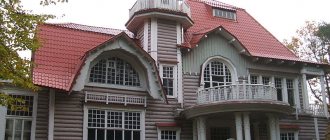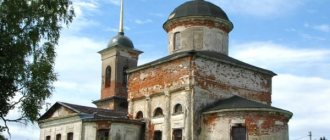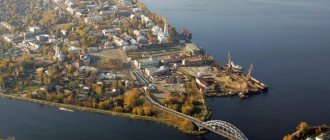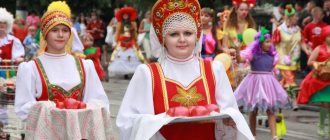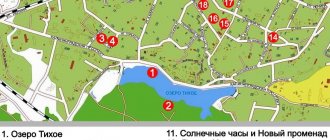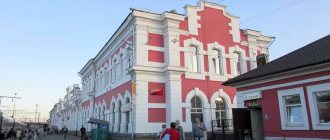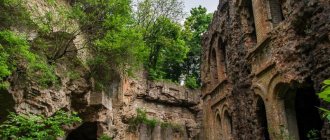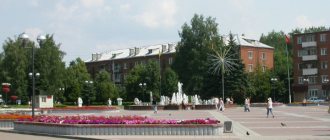Pechory is a small town in the Pskov region. This is the westernmost populated area in Russia, excluding the Kaliningrad region. The main attraction of the Pechora region is the Holy Caves. Actually, the word “Pechory” is translated from Old Slavonic as “caves”. So a very interesting adventure awaits curious travelers. They will visit an ancient and incredibly atmospheric place. There the temporal merges with the eternal, and the earthly with the heavenly.
The importance of the city in the modern world
Pechory, whose attractions are ancient cathedrals and temples, is the administrative center of the Pechora district and an urban settlement called Pechory.
The first mention of a settlement located in this place dates back to 1392. The name of the settlement comes from the old Russian word “pechery”, which meant “caves”. From 1920 to 1940 the city was called Petseri.
The founding date of the settlement is considered to be 1472. At this time, an Orthodox priest named Ioan founded the first monastery on this site. This event was preceded by the destruction of Orthodox churches by the Germans in the city of Tartu (Dorpt).
In 1782, the settlement of Pechory, by order of Catherine II Alekseevna the Great, acquired the status of a city in the Pskov region. Pechory, along with the Kaliningrad region, is considered the westernmost Russian city. It is located 53 km from the regional center.
In the north and east of the city flows a small river called Pachkovka. This is one of the tributaries of the Pimzha River, as well as the basin of Lake Pskov. The length of the river is 19 km, the basin area is 82 km².
Geographic coordinates of the city: 65.14716 north latitude, 57.22439 east longitude. The city center is located at an altitude of 85 m above sea level. The total area of the city is 20.55 km².
The main events that took place in the city at different times:
| from the 16th century to the beginning of the 18th century | Pechory is the main strategic point in western Russia |
| 16th century | Knights - Catholics of Livonia destroyed the most ancient monastery of the city |
| from 1529 to 1570 | Temples are being restored and restored, watchtowers are being built and gates are being strengthened. |
| 1565 | By decree of Ivan the Terrible, the city of Pechora became part of the zemshchina |
| 1581 – 1582 | The siege of Pechora by King Stefan Batory of Poland takes place. |
| 1611 – 1616 | siege of Pechora by Polish and Swedish troops |
| 1701 – 1703 | second siege of Pechora by Swedish troops led by Charles XII |
| 01/09/1783 | city coat of arms approved |
| 01/11/1797 | Pechora district was liquidated |
| 08/04/1889 | railway traffic has been formed along the Pskov-Riga road, laid next to the city |
| 1899 | the first railway station was founded |
| 1914 | 2 primary ministerial educational institutions were organized in the city |
| 1918 | the city is occupied by German troops |
| 02/04/1919 | the city was conquered by the Estonians |
| 03/11/1919 | the city was liberated by the Red Army |
| 03/29/1919 | Estonians retake the city again |
| 1920 | the city is officially part of Estonia |
| 1931 | Pechory railway station becomes a railway junction |
| 05/24/1939 | A terrible fire destroys almost the entire city |
| 1940 | the city of Pechory, part of the Republic of Estonia, joined the USSR |
| 07/10/1941 | the city is occupied by Nazi Germany |
| 08/11/1944 | the city was liberated by Red Army soldiers |
| 08/23/1944 | Pechory is part of the RSFSR as part of the Pskov region |
| 2007 | Pechory is excluded from the list of border zones of the country |
City `s history.
The Orthodox priest Jonah fled from Dorpat (Tartu) towards the above-mentioned caves, which served as a good shelter for a man of strong spirit. His church, founded in Dorpat, was destroyed by Catholic Germans in 1472. In the same year, the fleeing Jonah laid the first stones of the future monastery on Pskov land, and a year later he consecrated the cave Assumption Church. Over time, buildings appear around, permanent residents move in - this is how the settlement is born, which is called Pechory, from the caves known to us.
Climate
Pechora, whose attractions are its unique flora and fauna, has a moderately cold climate. According to the comfort rating, July and August are considered the best months to travel.
Average air temperatures calculated taking into account the last few years:
| month | day °C | night °С | sunny days | precipitation in mm | wind speed in m/s | rainy days |
| January | -4,4 | -8,5 | 2 | 31,12 | 3,6 | 6 |
| February | -2,8 | -7,6 | 1 | 26,95 | 3,4 | 5 |
| March | +1,2 | -4,8 | 3 | 21,66 | 3,6 | 9 |
| April | +9,5 | +0,9 | 11 | 26,05 | 3,3 | 14 |
| May | +17,4 | +6,4 | 19 | 30,16 | 3,1 | 15 |
| June | +19,9 | +9,4 | 16 | 45,27 | 3,3 | 18 |
| July | +23,6 | +12,9 | 17 | 44,46 | 3,1 | 18 |
| August | +21,7 | +11,6 | 17 | 42,54 | 3,1 | 17 |
| September | +16,3 | +8,2 | 12 | 25,57 | 3,4 | 15 |
| October | +8 | +2,5 | 9 | 34,9 | 3,6 | 14 |
| november | +3,2 | +0,0 | 2 | 34,48 | 3,6 | 12 |
| December | -1,2 | -4,5 | 2 | 31,69 | 3,9 | 9 |
Ecology
Pechory, whose attractions attract many tourists, is located on the western side of the Pskov region.
The environmental situation in the Pskov region, and in particular in the city of Pechory, is not entirely favorable. The negative impact on the environment is caused by unauthorized dumping of industrial waste, an insufficient number of authorized landfills and the lack of waste recycling facilities.
The region's water resources are affected by wastewater discharges.
At the end of the last century, in the Pskov region there were burials of unusable agrochemicals and pesticides. The largest testing site was located in the Pskov region near the village of Korsakovo. In the town of Nevele there is an oil sludge storage facility, which has recently been in unsatisfactory condition.
Local residents of Pechora have repeatedly complained about the huge amount of hogweed that has filled the entire territory of the suburb. Every year, a huge number of people go to hospitals with complaints of external and internal burns from this plant.
City `s history.
At the beginning of the 20th century, Pechory boasted eleven streets and five squares. But the houses here are almost all wooden, of which only seven are built of stone and six have stone facades. Thirty-one kerosene lanterns illuminated the city streets, and the water supply was provided by numerous wells and the Pachkovka River. The industry did not shine with variety: there was only one tannery for the entire town. But there are a huge number of folk craftsmen. After the First World War, Pechory, recaptured by Estonian troops from the Red Army, came into the possession of the Republic of Estonia, and therefore was renamed Petserimaa (Petseri). This was the most intense period in the history of the city; you can learn about it in more detail at the exhibition of the local history museum. It is called "Pechory - Petseri and its inhabitants."
Population
According to the latest census (2022), the number of local residents was 9,670 people. The residential density in the city is 470.56 people per km².
Basically, the following people live on the territory of Pechora:
- Russians, almost 90%;
- Ukrainians – 3%;
- Belarusians – 1.5%;
- Estonians – 1.5%;
- Setu people – 0.5%.
Local residents are called:
- Pecheryans;
- Pecheryanin;
- pecheryanka
Pechora River basin
From the spot indicated above, the Pechora River (which has ceased to be a stream since the entry of Unya) moves like a mountain river, overcoming rapids and intermediate rifts all the way to the village of Yakshi. At this landmark (after connecting with Volostnitsa) the first turn to the north takes place. And the width of the river is at least 200 meters. In addition, through each section of the same length it expands 2 times and “receives” an island. All this time, having descended from the high mountains, the river flows among the taiga, especially rich in species. It envelops the territory of the Pechero-Ilychsky Nature Reserve from the south. The high rocky outcrops of rocks are memorable. By the way, the flow of the Pechora River turns west after the confluence of the Usa. Forms a wide knee, changing the vector of movement a couple of times. In the interval from the Usa branch to Ust-Tsilma, wide emerald meadows and tall grass stand appear on both sides. The width of the valley reaches 2 kilometers.
The mountains do not approach the water, but are still clearly visible. The landscape on their slopes retains the same type. The height of the water edges themselves changes dramatically. The root bank remains a rather high ravine, while the opposite bank remains a swampy area. Always. From Ust-Tsimla the flow of the Pechora River is northern. The Riviera is clayey and sandy, but there are also wide pebble spits on the fairway. The largest branches flow into the main flow. The middle fragment is also remembered by the appearance of permanent ducts (“balls”).
From this point on, the “artery” is no longer solid, resembling a “faggot” from reservoirs. The islands are getting larger. The oxbow lakes are increasing in number. The sides of the channel drop even more. But in some places they rise later. Here comes the lower reaches! There are significantly more swamps and open areas than forests. And the greenery is represented only by larch (decreasing in size), dwarf cedar and reed grass.
130 kilometers from the mouth, the Pechora River basin is divided into 2 branches. Here the hydrological object passes the border of the lands of the Nenets Autonomous Okrug. A feature of the “border” segment can be taken to be the gradual disappearance of the rise even on the main bank, a slow transition to an exclusively dwarf coniferous “forest” and an increase in the area of swamps on the borrowing side. Before Naryan-Mar, the Pechora River basin becomes completely flat. And it is now surrounded not by taiga, but by forest-tundra. And after passing through the city, it leads the “water workers” into the tundra. The mouth of the object has already been described above. Where it is located, the width of the river valley is 45 km.
Flora and fauna
The sights of a small town called Pechory are very diverse; the flora and fauna of the region are quite interesting.
The territory of Pechora is dominated by taiga and mixed forests, in which grow:
- linden and aspen;
- maple and elm;
- ash and birch;
- alder and willow;
- oak, pine and spruce.
Almost 1.5 thousand species of ferns and more than 80 species of mushrooms grow here. The fauna of the Pskov region is very rich.
Here you can find animals:
- wild bear and lynx;
- fox and ferret;
- beaver and muskrat;
- numerous rodents.
Of the amphibians and reptiles found:
- newts and toads;
- frogs and toads;
- copperheads, lizards and vipers.
About 40 species of fish live in local reservoirs:
- whitefish and crucian carp;
- pike perch and burbot;
- tench, bream and pike.
Here you can find rare endangered animals such as:
- muskrat and roe deer;
- mink and elk;
- raccoon dog and squirrel;
- hedgehog and weasel;
- hare and marten;
- deer, badger and yellow-throated mouse.
How to get there
Pechora, whose attractions include numerous sculptures and memorials, is adjacent to the Russian-Estonian border through two road crossings: Shumilkino and Kunichina Gora. There are several ways to get to Pechora.
By plane
Air terminals closest to the city:
- at a distance of 107.59 km – Usinsk airport;
- at a distance of 176.29 km is Vuktyl Airport.
By train
You can get to the city by rail. At a distance of 3 km from the city there is the Pechory-Pskovskaya railway station, where long- and short-distance trains stop.
By car
From almost anywhere in Russia, you can get to Pechora by car.
Don't miss the most popular article in the section: Metro Nizhny Novgorod. Diagram, map, description.
Pechory. Lutheran Church of St. Peter.
The Lutheran Church of St. Peter attracts special attention. This is the first Lutheran church on the southern border of Estonia, consecrated in 1926. Its name then was more authentic than today - Pechora Evangelical Lutheran Church of St. Peter. It was built on the initiative of citizens. The organ was also bought all over the world, in 1928, from the Estonian company Kriisa. It is called “romantic” because it was created according to all the canons of romanticism: it has a soft and deep sound and the ability to perform many different melodies. And the organ of the Lutheran church is one of ten historical organs preserved in Russia. From April to October, everyone is invited to organ music concerts. Ticket prices are low and all funds go to donations - despite its functionality, the instrument requires restoration.
Types of transport in the city
The most popular and accessible form of transport in the city of Pechory is the bus. Every day numerous buses travel on the city roads along approved routes.
Numerous passenger transportation companies offer taxi services. You can order a car by phone, via the Internet, or catch a car on the city streets. Estimated taxi fare is from 10 rubles. per km. There is an hourly fare - from 200 rubles. in 1 hour.
The cost of landing is from 10 to 100 rubles. The minimum fare is 70 rubles. Transportation of large luggage from 50 rub. Cost of idle taxi car from 3 rubles. in a minute.
You can also rent a car without a driver. If you have documents (passport, driver's license), you must pay and arrange insurance. The cost of a car without a driver per day is from 800 rubles. The price depends on the duration of the rental and the brand of the car.
Main attractions
Numerous attractions are located in the city and its surroundings.
Religious buildings
https://www.youtube.com/watch?v=hf8ZlFmHQL8
The Pskov-Pechora Fortress is located at: st. Mezhdunarodnaya, building 5. The fortress, erected to protect the monastery, has an observation deck in the upper part. You can see the architectural landmark daily from 9:00 a.m. to 4:00 p.m.
Pechora Fortress - the main attraction of the city of Pechora
You can get to the territory of the Petrovsky Bastion by going down to the foot of the monastery, which is located behind the Pskov-Pechora fortress. The bastion was founded in the 16th – 17th centuries by order of Peter I, with the aim of defending the city during the Northern War.
The mansion of T. G. Rusakov is located at the address: Pskovskaya street, building 32. The mansion is an architectural structure in the neoclassical style. The wooden 2-story mansion has a stone basement. The mansion belonged to Rusakov, a well-known timber merchant in these parts.
Museums
The Museum of the History of the City of Pechora is located at: st. Mezhdunarodnaya, building 6. You can visit the museum from 11.00 to 18.00 Wed. – Sun., Mon. – Tue. weekend.
The cost of visiting the museum for an adult is 100 rubles, schoolchildren – 30 rubles, students and pensioners – 50 rubles. This is the oldest museum in the city, where you can get acquainted with exhibits telling about the cultural and historical life of the city.
Works of art by artists are exhibited here:
- N. Roerich;
- A. F. Shnyavina;
- L. A. Mikstaisa;
- P. D. Melnikova.
The museum organizes exhibitions:
- archaeological;
- ethnographic;
- visual arts;
- dedicated to ceramics and porcelain;
- exhibition of the history of Soviet times.
Location of the international cultural center: st. Svobody, building 29. The center is opened in the building of the “House of the People’s Druzhina”, which has a capacity of 250 places. Exhibitions and cultural events dedicated to the development and creative potential of Pechora’s youth are held here.
The Seto Estate Museum is located at the address: Sigovo village, Pechora district. The museum is open daily from 10.00 to 17.00. Ticket price for an adult is 20 rubles, for children and students – 10 rubles. The cost of group excursions is 500 rubles. This is the only museum in the world dedicated to the life and way of life of the Finno-Ugric Seto people.
The exhibits include:
- antique chests and chests;
- chests of drawers and decorations;
- items made from natural sheep wool;
- things made by the hands of blacksmiths of the Seto people.
Natural attractions
Lake Velye is located at a distance of 9 km in the south-west direction from the city of Izborg, Pechora district, Pskov region. This is a picturesque lake, which is considered a natural attraction of the region. The lake is surrounded by a dense forest of mixed tree species.
Under the buildings of the Pskov-Pechora Monastery there are Sacred Caves. The length of the underground caves is 200 m. The air temperature stays at +5 °C all year round. The caves are a kind of necropolis, where more than 10 thousand monks and lay people were buried in ancient times. There are no analogues of this cave in the world.
The Pechora River, flowing through the territory of the Pskov region, is the largest and most abundant river in the European North.
It flows between 2 mountain peaks called “Pechery-Talakh-Chakhl” and “Yengile-Chakhl”, which are located at an altitude of 296.8 m above sea level. The length of the river is 1,809 km, the drainage area is more than 320 thousand km². The general river basin consists of 35 thousand small rivers and more than 60 thousand lakes.
Monuments
The carriage of Empress Anna Ioannovna was installed on the territory of the Holy Dormition Monastery on the street. Mezhdunarodnaya, building 5. You can view the stroller for free, from 9.00 to 16.00 daily. The stroller was personally left at this place by Empress Anna herself during her trip to the Pskov land.
The monument to the street lamp was erected on December 10, 2011, the architect of the monument is Alexander Bushuev. Street lamps are a symbol of the city streets of Pechora; it was decided to install the monument on Oktyabrskaya Square.
The monument to the Venerable Cornelius Hegumen of Pskov-Pechora (killed by Ivan the Terrible) was installed on the street. Podgornaya, opposite the Holy Dormition Monastery. Date of installation of the monument: October 4, 2012
Sights of the city of Pechora – TOP-3
The most interesting sights of Pechora are located in the Pskov-Pechora Lavra. They are steeped in ancient legends and will seem interesting to any tourist. You can explore them in one day by going on an excursion yourself.
Holy Dormition Pskov-Pechersky Monastery
- Address – International, 5.
Founded in 1473. It began with the microscopic monastery of John Shestnik (the traveler). He dug a grotto not far from the caves created by God and turned to the Orthodox Church with a request to illuminate the place.
On the day of the Dormition of the Blessed Virgin Mary, the new cave church was illuminated. She bears the name of her patron saint. The temple is called the Assumption Church.
Later the monastery grew to the size of the Pskov-Pechora Lavra. Now it has a very complex planned structure. It consists of several temples, a fortress, a sacristy, a bell tower and other interesting places that are worth seeing.
It is noteworthy that the monastery was never closed. Even during the difficult years of Soviet power, its doors were open to parishioners. This is due to the fact that in the period from 1920 to 1945. it was located on the territory of independent Estonia.
Today the monastery is thriving. It remains one of the most respected religious centers in Russia, attracting hundreds of thousands of pilgrims every year who come here every day.
God-Ordained Holy Caves
- Coordinates on the map are 57.809401, 27.614391.
The first mention of them occurs in 1393. According to legend, monks from the Kiev Pechersk Lavra hid in the caves from the Tatars. Later they were ennobled.
Now the vaults have been lined with bricks and converted into a monastery cemetery. There are about ten thousand burials in the caves. Laymen and pilgrims, knights and priests rest in this incomprehensible and mysterious place. Coffins are not buried in the ground, but placed in special niches. At the same time, the smell of decay is completely absent.
The caves occupy a huge area. Seven streets lead to the burials. Tourists are not allowed into the farthest grottoes. Photography is also prohibited here.
Assumption Church
- Address: Bloody Path.
We are talking about the main and most ancient temple of the monastery. It was illuminated in 1473 and has only a front façade because the rest goes uphill. In the 19th century, colored domes were erected over the church. In shape they resemble the heads of the Kiev Pechersk Lavra.
Leisure
For lovers of active recreation, parachute jumping is organized in the city. The estimated cost of the jump is from 3.5 thousand rubles. up to 4 thousand rubles
There are numerous bicycle rental points in the city. A bicycle ride around the city will bring great pleasure to adults and children. Fishing master classes are regularly held on Lake Velje. Numerous fishermen from different cities and villages come here.
The lake is rich in fish:
- pike and roach;
- perch and crucian carp;
- bream and white bream.
Protection of the Pechora River
The protection of the Pechora River in the Komi regions is carried out according to a recently developed program. It is called “Improving the ecology of the Pechora River basin.” The fact is that many of its tributaries have oil production enterprises. Additional hydraulic structures for the treatment system are being installed. A separate area of security activity is preventing the dangerous effects of floods. Funds have been allocated to register flood sites in a special cadastre. Now, as for coal mining. Mine waters, entering the Usa branch, are washed into the main Pechora stream. The heads of mining companies were issued a corresponding resolution to take measures to eliminate the described situation. In the very lower reaches, the protection of the Pechora River also takes place as part of official events planned by the government of the Nenets Autonomous Okrug. The scourge here is industrial and domestic wastewater from the Naryan-Mar agglomeration. And especially the oil terminal. During the sampling, phenols, zinc, copper and pesticides were found in addition. 93 abandoned watercraft were identified. The relevant authorities issued fines to those involved in environmental violations. Ordinary citizens, to help the reservoir, clean its banks from unauthorized dumps.
The description of the Pechora River shows all the recreational and extreme leisure opportunities of this reservoir. The landscapes on its banks change 4 times. Therefore, the “water road” should be recommended to lovers of nature, rafting, hiking and climbing. And along this riverbed many different national traditions have been preserved.
Interesting places to relax with children
An interesting holiday for the whole family can be a boat trip to the Talab Islands, which are located in the southeast of Pskov Lake. In the city of Pechory you can rent a Segway (from 8 years old) or a hoverboard (5 years old).
Rental cost:
- 5 minutes. – 100 rub.;
- 10 min. – 200 rub.;
- 20 minutes. – 300 rub.
A trip to the Izborsky Ostrich eco-farm can be an excellent family vacation. The eco-farm is open daily from 10.00 to 19.00. Black African ostriches and reindeer are bred there.
Parks and squares of the city of Pechora
Recently, Pechory has been actively being improved. If earlier it was a cute town, but literally drowned in greenery, now it has parks and public gardens.
Malskaya Valley
- Address - Ski complex Malskaya Dolina, Training slope.
Active recreation park. Suitable for children and adults. Specializes in different types of services. In winter, Malskaya Dolina is a ski resort. It offers visitors eight trails of varying difficulty for alpine and cross-country skiing. There is a slope for cheesecakes. In summer, ATV rides, cycling, and rope courses are available. For lovers of outdoor recreation, camping is organized.
Park of Culture and Recreation "Triangle"
- Address: Gagarin Street.
Located in the center of the city. It got its name due to its triangular shape. A cozy green park with all the attributes of improvement. There are benches, lanterns, paths, and a fountain.
All public city events are held in this small area, surrounded on all sides by noisy streets. The townspeople love this park very much; they come there for walks with the whole family.
In the park there is a memorial “Grieving Mother with Son” - this is one of the most revered places among the residents of Pechory. 206 Soviet soldiers who died in the fire of the Great Patriotic War are buried here.
Topic: Sights of the Pskov region
Excursions
Tourists are offered a variety of excursions to the cities of the Pskov region.
Excursion to Pechory, Pskov-Pechora Monastery
The cost of the excursion is from 3 thousand rubles. per person. During the excursion, you will get acquainted with the 16th-century fortress and visit the Holy Dormition Monastery. Visit to the famous caves, which are located in the underground of the monastery. The price includes excursion support.
Meals and transportation are paid separately. Approximate duration of the excursion is 6 hours.
Excursion to the Talab Islands
The cost of the excursion is from 1.5 thousand rubles. up to 4.5 thousand rubles. per person. The islands are located 25 km from Pskov. During the boat excursion, a visit to the islands is provided. Belov and im. Flooded. Inspection of the Cathedral of St. Nicholas and the house of Elder Nikolai Guryanov. Also, a walk through the pine forest, gardens and swimming in Lake Pskov. The tour lasts approximately 4 hours to 8 hours.
Combined excursion “Pskov – Izborsk – Pechory”
The cost of the excursion is from 3 thousand rubles. per person. During the excursion, you will visit 3 cities in turn. Inspection and visit to the main religious attractions of the cities and a walk through historical places. Estimated tour time 10 hours.
Pskov-Pechersky Monastery.
It is characteristic that the monastery, which survived so many wars and hardships over all 5 centuries, was never closed (even the NKVD failed to do this). Nowadays, the restored monastery is very beautiful. The dark blue domes of the Assumption Church with gold stars, the gilded domes of St. Michael's Cathedral can be seen from afar. The holy caves store the relics and tombstones of monks and “military men” who died defending the monastery. In the inscriptions on the tombstones you can see the names of the Suvorovs, Rtishchevs, Nashchekins, Buturlins, Mstislavskys. The ancestors of Pushkin, Kutuzov, and Mussorgsky were buried in the monastery caves.
Route for exploring the city on your own in 1-2 days
In addition to excursion tours offered by travel agencies, it is advisable to prepare a route for independent movement around the city.
1 day stay in the city:
- Visit to the Holy Dormition monastery buildings.
- Inspection of the Holy Caves located under the monastery
- Inspection of the Empress's carriage.
- Visit to St. Michael's Cathedral.
- A trip to the Sagittarius house.
- Excursion to an eco-farm where ostriches are kept.
- Inspection of the lantern monument.
- Excursion to the water tower.
2nd day of stay in the city:
- Inspection of Rusakov's house.
- Excursion to the Pechora History Museum.
- Visit to an international cultural center.
- Visit to the Church of the Forty Martyrs of Sebaste.
- Excursion to the Seto Museum.
- Excursion to the Petrovsky Bastions.
- Trip to Pechora Lake.
Temple and church pearls
One can talk endlessly about the churches of the Pskov-Pechora Lavra. Each of them is a real treasure. And it’s not even about the cultural value of the objects. The decoration of Pechora churches is distinguished by splendor and luxury.
Sretenskaya Church
- Address: Holy Dormition Pskovo-Pechersky Monastery.
This Orthodox shrine was erected in the middle of the 16th century. Until the middle of the 19th century it served as a refectory. Then it was rebuilt into a temple. Made in a special pseudo-Russian style.
The shrines that are especially revered here are the relics of St. Semeon, the “Seeking the Lost” and “Three-Handed” icons. On the walls of the building there are paintings with illustrations of the Holy Scriptures.
The Sretenskaya Church has an unusually beautiful iconostasis. It is decorated with carvings and gilded columns. There are many ancient utensils in the temple. Hammered lamps and forged candlesticks have been preserved.
St. Michael's Cathedral
- Address: Holy Dormition Pskovo-Pechersky Monastery.
Illuminated at the beginning of the 19th century in honor of the victory over Napoleon. It is the largest building of the Lavra. The author is an Italian architect. He completed the cathedral in a classical style. There are two main values in the church - the Tenderness icon and the right hand of the holy martyr Tatiana. The cathedral is the dominant feature of the entire architectural ensemble of the Lavra. He is the most pompous and majestic.
Church of the Intercession
- Address: Pskov-Pechersky Monastery.
It has a common facade with the cave Assumption Cathedral. It is distinguished by its extraordinary beauty. Erected in the mid-18th century. The first service took place in 1759. The iconostasis of the temple is amazing. Wall paintings surprise with their art. The extraordinary silence inside the church leaves visitors in awe. Here you can feel the depth of centuries, the power of the Orthodox cultural tradition.
Annunciation Church
- Address: Mezhdunarodnaya st., 5.
The facade of this church is red. It became one of the first stone buildings of the monastery complex. Created in the 16th century. Adjacent to the Sretensky Church. It has a special architecture. Under the blue dome there is a belt of ceramic slabs. This element is characteristic of the early tradition of Pskov .
Church of the Holy Great Martyr Barbara
- Address - Cathedral Square, 1.
It is also worth mentioning this parish, which is not part of the monastery, but is only located near it. It belongs to the Orthodox part of the Seto people, as a result, services here are conducted not only in Church Slavonic, but also in Estonian.
The Varvara Church was built in 1779 - on the site where the chapel of St. Vmch. Barbarians. An interesting fact is that the shrine was not closed during the USSR, continuing to receive parishioners.
Temple of Saints Methodius and Cyril Equal to the Apostles, Slovenian teachers
- Address - st. Yuryevskaya.
Opened on August 29, 2022. Located on the territory of the Pilgrimage Center. It took four years to build. It pleases the eye with its majestic and noble appearance. The temple has an interesting color scheme. It stands on a high brown foundation. The outside of the building is lined with yellow-beige brick. And all the contours are painted dark brown. The domes are also brown. They have golden crosses on them.
Parishioners love to visit this temple. It is tall and bright, with excellent acoustics and beautiful decoration. Solemn services with soothing chants are held on weekends and holidays. Then many townspeople rush to the church to feel love and peace.
Hotels
Hotels of various price categories invite city guests.
Guest House "Pilgrim's Way"
The cost of a hotel room starts from 5.9 thousand rubles. per night. The hotel is located at: Pechory, st. Mezhdunarodnaya, house 10.
The hotel has 7 rooms, including:
- luxury;
- family;
- with kitchenette;
- for non-smokers.
The hotel offers:
- free parking and transfer from and to the airport;
- free internet and refrigerator in the room;
- concierge and microwave;
- Room service and shuttle bus.
Breakfast is available for an additional fee.
Hotel "12 months"
The cost of a hotel room is 1.7 thousand rubles. per night. The hotel is located at the address: Pechory, Oktyabrskaya Square, building 6. The hotel has 23 rooms, which are located in two adjacent buildings. There are standard rooms and superior rooms.
The hotel offers:
- restaurant and free parking;
- room service and free internet;
- showers and toilets on the floor (in standard rooms);
- cooler with hot and cold water (on the floor);
- refrigerator and electric kettle;
- Microwave and hair dryer;
- ironing board and iron.
Hotel Planet
Hotel location: Pechory, st. Mira, house 10. Room cost from 2 thousand rubles. per night.
The hotel offers its guests:
- free internet and refrigerator in the room;
- air conditioning and free parking;
- concierge and shuttle bus.
The hotel allows pets. The hotel has only 35 rooms, including non-smoking and family rooms.
Hotel "Pechory-Park"
The cost of a hotel room starts from 1.2 thousand per night. Hotel location: Pechory, st. Gagarina, house 2 "b".
The hotel has a total of 22 rooms, including:
- for non-smokers;
- family;
- luxury;
- rooms with kitchenette.
The hotel offers:
- bar and free parking;
- room service and free internet;
- restaurant and concierge;
- babysitting services and wheelchair ramps;
- refrigerator in the room and shuttle bus.
The hotel allows pets.
Hotel "Black Cat"
Price per hotel room from 1.7 thousand rubles. per night. The hotel is located at: Pechory, October Square, building 7. The hotel has only 5 rooms. There are non-smoking and family rooms.
The hotel offers:
- restaurant and conference room;
- free parking and room service;
- free internet and breakfast.
- banquet hall and air conditioning.
What to bring as a souvenir
The most popular souvenirs from the city of Pechora:
- goods purchased at the monastery;
- wicker items made of wicker and carved jewelry;
- various knitted sheep's wool clothing;
- printed gingerbread from the city of Izborsk;
- memorable souvenirs purchased at the Russian song festival in the city of Pechory;
- goods purchased from the Lutheran Church.
You can also purchase souvenirs in specialized stores:
- "Pskotsvet", on the street. ;
- “Flower and Gift Shop”, on Oktyabrya Square, building 6;
- “Pechorsky Souvenir”, on the street. Mezhdunarodnaya, building 2 "b".
The attractions of the small town of Pechora are numerous fortresses and temples. The city often became a target for foreign invaders, so the surviving structures are historically important objects protected by the state.
Author: Olga Zhanskaya
Article design: Vladimir the Great
Pskov-Pechersky Monastery.
In 1920, after the signing of the Tartu Peace, Pechory became Estonian territory. The next 20 years were calm and prosperous for the monastery, the buildings were restored, and a Theological Academy was opened in the monastery. But in 1940, Estonia became a Soviet republic. A year later, World War II arrived here. Retreating, the Germans took the monastery treasury to Riga and then to Germany. From there it was returned only in 1971. And the monastery library was brought from Tartu in 1991.
